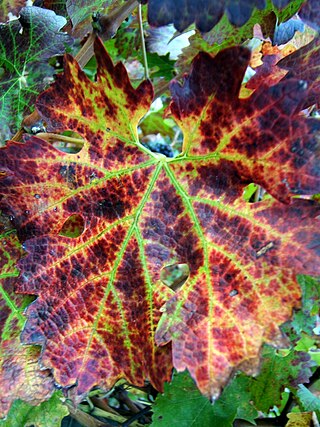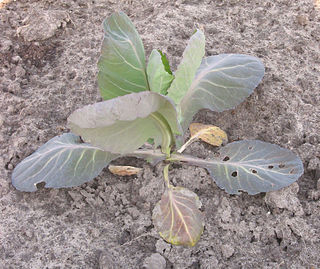Related Research Articles

Compost is a mixture of ingredients used as plant fertilizer and to improve soil's physical, chemical and biological properties. It is commonly prepared by decomposing plant, food waste, recycling organic materials and manure. The resulting mixture is rich in plant nutrients and beneficial organisms, such as bacteria, protozoa, nematodes and fungi. Compost improves soil fertility in gardens, landscaping, horticulture, urban agriculture, and organic farming, reducing dependency on commercial chemical fertilizers. The benefits of compost include providing nutrients to crops as fertilizer, acting as a soil conditioner, increasing the humus or humic acid contents of the soil, and introducing beneficial microbes that help to suppress pathogens in the soil and reduce soil-borne diseases.

Hydroponics is a type of horticulture and a subset of hydroculture which involves growing plants, usually crops or medicinal plants, without soil, by using water-based mineral nutrient solutions in aqueous solvents. Terrestrial or aquatic plants may grow with their roots exposed to the nutritious liquid or in addition, the roots may be mechanically supported by an inert medium such as perlite, gravel, or other substrates.

Crop rotation is the practice of growing a series of different types of crops in the same area across a sequence of growing seasons. It reduces reliance on one set of nutrients, pest and weed pressure, and the probability of developing resistant pests and weeds.
The following outline is provided as an overview of and topical guide to agriculture:

Physiological plant disorders are caused by non-pathological conditions such as poor light, adverse weather, water-logging, phytotoxic compounds or a lack of nutrients, and affect the functioning of the plant system. Physiological disorders are distinguished from plant diseases caused by pathogens, such as a virus or fungus. While the symptoms of physiological disorders may appear disease-like, they can usually be prevented by altering environmental conditions. However, once a plant shows symptoms of a physiological disorder it is likely that, that season's growth or yield will be reduced.

Nitrogen deficiency is a deficiency of nitrogen in plants. This can occur when organic matter with high carbon content, such as sawdust, is added to soil. Soil organisms use any nitrogen available to break down carbon sources, making nitrogen unavailable to plants. This is known as "robbing" the soil of nitrogen. All vegetables apart from nitrogen fixing legumes are prone to this disorder.

Vermicompost (vermi-compost) is the product of the decomposition process using various species of worms, usually red wigglers, white worms, and other earthworms, to create a mixture of decomposing vegetable or food waste, bedding materials, and vermicast. This process is called vermicomposting, while the rearing of worms for this purpose is called vermiculture.
Good agricultural practice (GAP) is a certification system for agriculture, specifying procedures that must be implemented to create food for consumers or further processing that is safe and wholesome, using sustainable methods. While there are numerous competing definitions of what methods constitute good agricultural practice, there are several broadly accepted schemes that producers can adhere too.

A mulch is a layer of material applied to the surface of soil. Reasons for applying mulch include conservation of soil moisture, improving fertility and health of the soil, reducing weed growth and enhancing the visual appeal of the area.

Aeroponics is the process of growing plants in the air or mist environment without soil or an aggregate medium. The word "aeroponic" is derived from the Greek meanings of aer ("air") and ponos ("labour"). It is a subset of hydroponics, since water is used in aeroponics to transmit nutrients.

Environmental technology (envirotech) or green technology (greentech), also known as clean technology (cleantech), is the application of one or more of environmental science, green chemistry, environmental monitoring and electronic devices to monitor, model and conserve the natural environment and resources, and to curb the negative impacts of human involvement. The term is also used to describe sustainable energy generation technologies such as photovoltaics, wind turbines, etc. Sustainable development is the core of environmental technologies. The term environmental technologies is also used to describe a class of electronic devices that can promote sustainable management of resources.

Agricultural wastewater treatment is a farm management agenda for controlling pollution from confined animal operations and from surface runoff that may be contaminated by chemicals in fertilizer, pesticides, animal slurry, crop residues or irrigation water. Agricultural wastewater treatment is required for continuous confined animal operations like milk and egg production. It may be performed in plants using mechanized treatment units similar to those used for industrial wastewater. Where land is available for ponds, settling basins and facultative lagoons may have lower operational costs for seasonal use conditions from breeding or harvest cycles. Animal slurries are usually treated by containment in anaerobic lagoons before disposal by spray or trickle application to grassland. Constructed wetlands are sometimes used to facilitate treatment of animal wastes.

This article presents common techniques and facts regarding the cultivation of cannabis, primarily for the production and consumption of its infructescences. Cultivation techniques for other purposes differ.

Environmental vegetarianism is the practice of vegetarianism when motivated by the desire to create a sustainable diet that avoids the negative environmental impact of meat production. Livestock as a whole is estimated to be responsible for around 15% of global greenhouse gas emissions. As a result, significant reduction in meat consumption has been advocated by, among others, the Intergovernmental Panel on Climate Change in their 2019 special report and as part of the 2017 World Scientists' Warning to Humanity.

The NASA Clean Air Study was a project led by the National Aeronautics and Space Administration (NASA) in association with the Associated Landscape Contractors of America (ALCA) in 1989, to research ways to clean the air in sealed environments such as space stations. Its results suggested that, in addition to absorbing carbon dioxide and releasing oxygen through photosynthesis, certain common indoor plants may also provide a natural way of removing volatile organic pollutants.

Vertical farming is the practice of growing crops in vertically stacked layers. It often incorporates controlled-environment agriculture, which aims to optimize plant growth, and soilless farming techniques such as hydroponics, aquaponics, and aeroponics. Some common choices of structures to house vertical farming systems include buildings, shipping containers, tunnels, and abandoned mine shafts. As of 2020, there is the equivalent of about 30 ha of operational vertical farmland in the world.

Agricultural pollution refers to biotic and abiotic byproducts of farming practices that result in contamination or degradation of the environment and surrounding ecosystems, and/or cause injury to humans and their economic interests. The pollution may come from a variety of sources, ranging from point source water pollution to more diffuse, landscape-level causes, also known as non-point source pollution and air pollution. Once in the environment these pollutants can have both direct effects in surrounding ecosystems, i.e. killing local wildlife or contaminating drinking water, and downstream effects such as dead zones caused by agricultural runoff is concentrated in large water bodies.
French intensive gardening also known as raised bed, wide bed, or French market gardening is a method of gardening in which plants are grown within a smaller space and with higher yields than other traditional gardening methods. The main principles for success are often listed as soil improvement, raised beds, close spacing, companion planting, succession planting and crop rotation. Originating in France, the practice is very popular among urban gardeners and small for profit farming operations.
Organic hydroponics is a hydroponics culture system based on organic agriculture concepts that does not use synthetic inputs such as fertilizers or pesticides. In organic hydroponics, nutrient solutions are derived from organic plant and animal material or naturally mined substances. Most studies on the topic have focused on the use of organic fertilizer.
This glossary of agriculture is a list of definitions of terms and concepts used in agriculture, its sub-disciplines, and related fields. For other glossaries relevant to agricultural science, see Glossary of biology, Glossary of ecology, Glossary of environmental science, and Glossary of botanical terms.
References
- ↑ "How to Grow Your Own Fresh Air - TED 2009". 25 January 2009.
- ↑ Kamal Meattle Bio
- ↑ Pavlis, Robert (18 October 2016). "Kamal Meattle – Plants and Air Purification". Garden Myths.
- ↑ Wood, Ronald A.; Burchett, Margaret D.; Alquezar, Ralph; Orwell, Ralph L.; Tarran, Jane; Torpy, Fraser (20 July 2006). "The Potted-Plant Microcosm Substantially Reduces Indoor Air VOC Pollution: I. Office Field-Study" (PDF). Water, Air, and Soil Pollution volume. 175: 163–180. doi:10.1007/s11270-006-9124-z.